Patek Philippe Twenty~4: Complete Overview Of Two Decades Of Timeless Elegance
by Martin Green
One of the major challenges for any brand is designing a contemporary ladies’ watch. It is hard to describe what makes this such a challenge, but I believe that, in essence, the trouble is that a ladies’ watch must be everything at once.
Women often juggle a wide variety of responsibilities, personal and professional, while their wardrobe choices are not as clearly defined as that of men. This means that the perfect ladies’ watch needs to be appropriate for most occasions and most outfits.
This idea of universal versatility might also be what keeps most ladies’ watches from reaching “icon” level. Although that term is arbitrary, most ladies’ watches that we think of as “iconic” also have a masculine sibling (a big brother, if you will).

In just two decades the Patek Philippe Twenty~4 has become a brand pillar (here: Ref. 4910/1200A-001)
But there are exceptions to this, and one is the topic of this in-depth look at the Patek Philippe Twenty~4.
Party like it’s 1999
Versatility was at the top of Patek Philippe’s thoughts when the firm designed the Twenty~4. The goal was to achieve “a beautiful expression of today’s contemporary woman” by creating a watch that can accompany women all day long. Hence the “24” in its name.
Patek Philippe tackled this challenge by going back to basics without becoming boring. The Twenty~4 was inspired by the manchette-style bracelets en vogue during the Art Deco period.
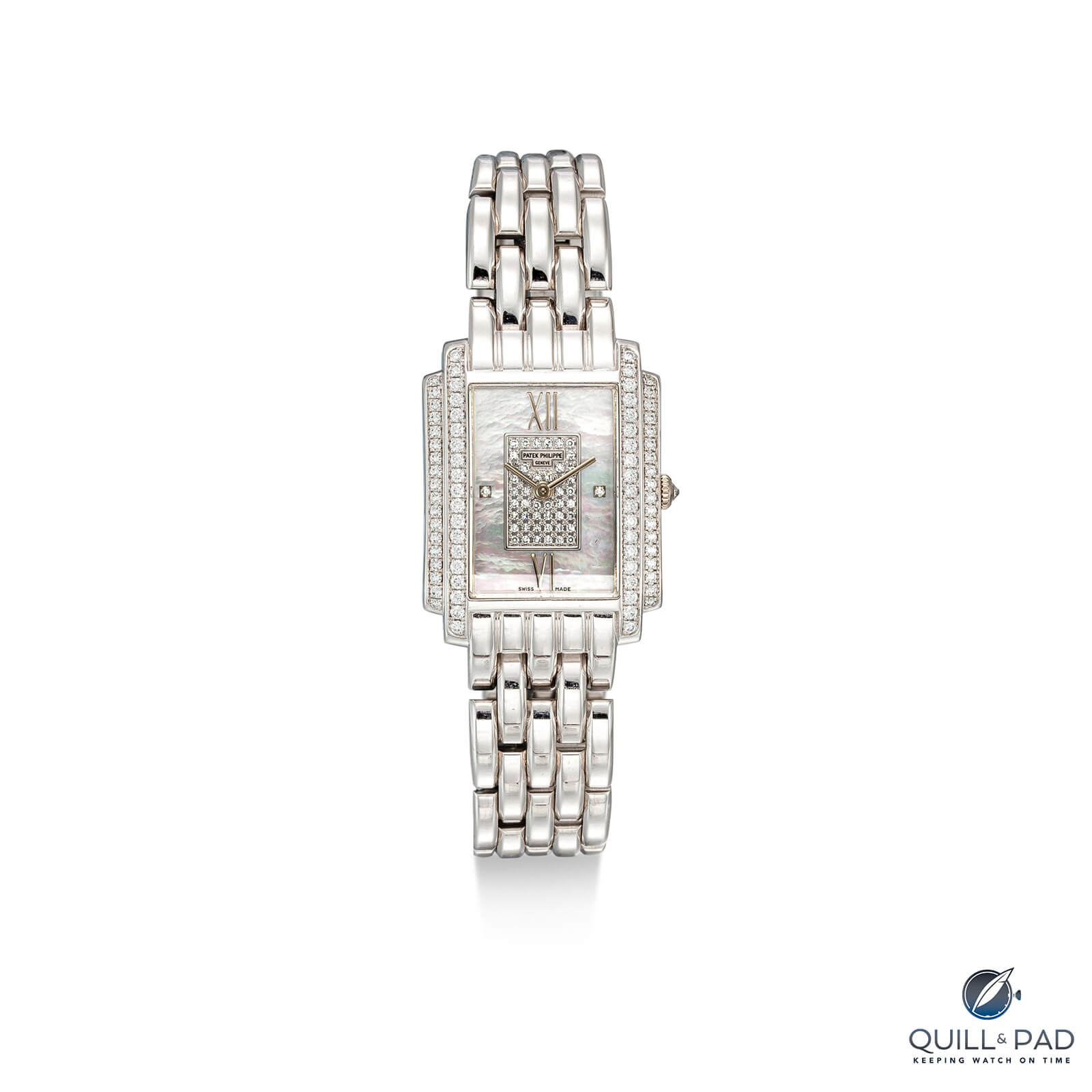
See the similarities? Patek Philippe Gondolo Ref. 4825 from approx. 2006 (photo courtesy Sotheby’s)
Some might also recognize the Twenty~4 as a more stylized version of the Gondolo, and they would not be wrong. There is most certainly a resemblance, especially when you look at Gondolo References 4824 and 4825, both introduced in 1993.
Yet where the Gondolo leans more toward being a classic proposition, the Twenty~4 is profoundly contemporary in appearance. By cleverly combining rectangular shapes, Patek Philippe found the perfect balance between being a piece of jewelry and a watch, giving the Twenty~4 an instantly recognizable profile as well as ensuring superb wearing comfort.
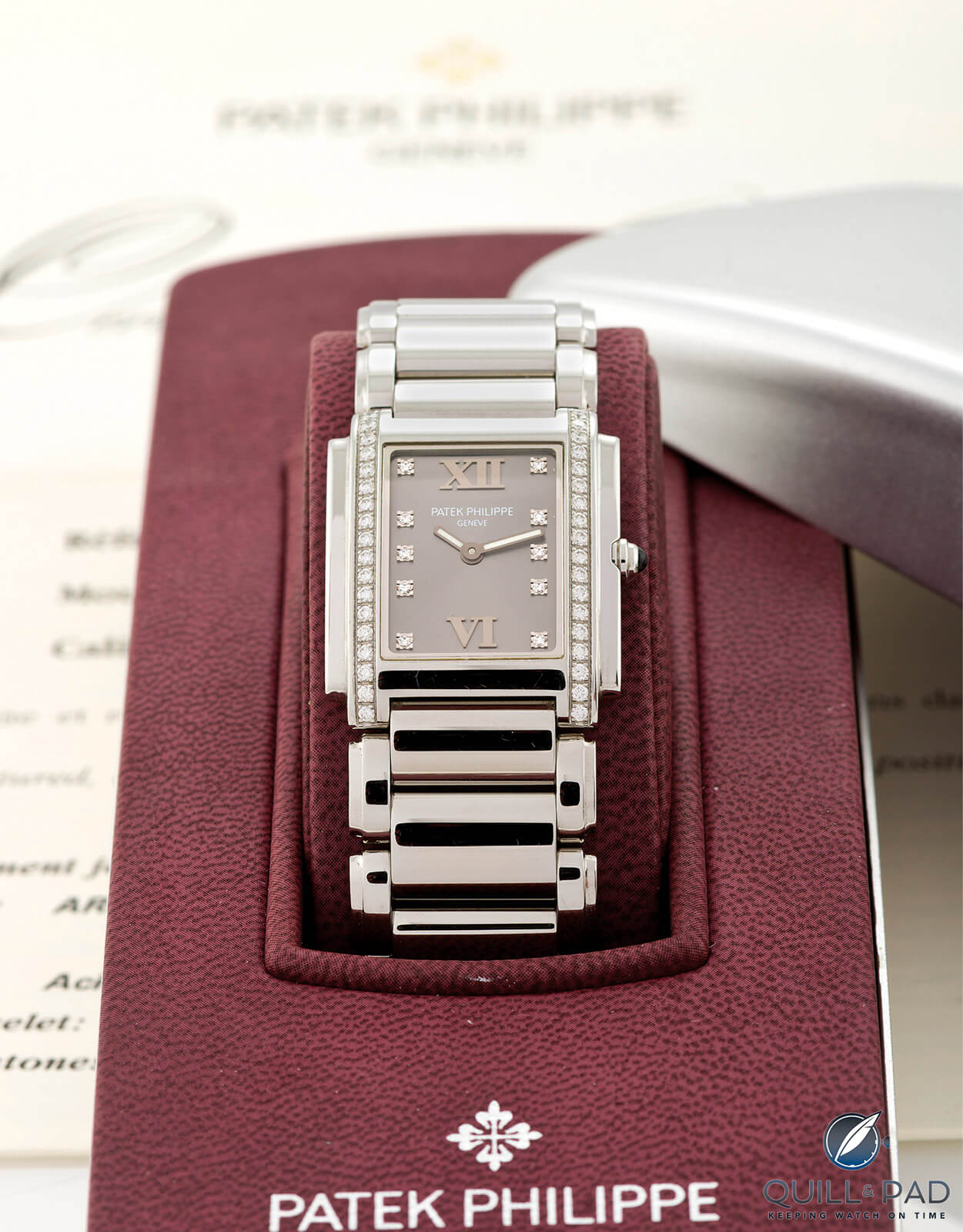
The model that started it all in 1999: Patek Philippe Twenty~4 Eternal Grey Reference 4910/10A-010 (photo courtesy Antiquorum)
It was not only the design that made the Twenty~4 stand out, it was also the choice of materials. When Patek Philippe launched the Twenty~4 in 1999, it did so with three models, all of which combined a stainless steel case and bracelet with brilliant-cut diamonds set on the brancards.
Each variation was named after the color of its dial, which featured prominent Roman numerals at 12 and 6 o’clock, with the remaining hours marked by diamonds. The monikers were more colorful than the dials, however: Forever Black (Reference 4910/10A-001), Eternal Grey (Reference 4910/10A-10), and Timeless White (Reference 4910/10A-11).
At 25.1 mm wide and 30 mm high, Patek Philippe got the proportions just right. These measurements gave the watch a presence but it wasn’t overly big, a compromise ensuring wearing comfort.
At 6.8 mm high, the Twenty~4 was also a relatively thin watch, which, combined with the manchette-style bracelet, helped to keep the watch flush against the wrist.
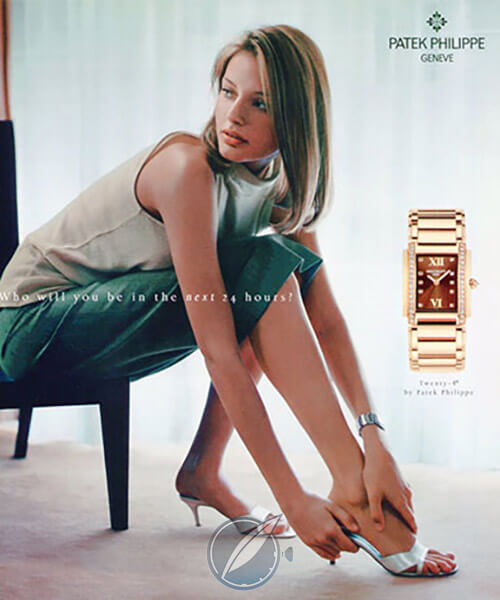
As always, Patek Philippe’s advertising is very effective
Patek Philippe has always taken a modest approach to advertising: there are no roaring race cars adorned with a Calatrava cross or watch-wearing celebrity spies rescuing the world on the big screen.
Instead, Patek Philippe focuses mainly on advertising campaigns that hit the right spot.
In 1996 Patek launched its “Generations” ad campaign, showing a parent and child with the tag line “You never actually own a Patek Philippe. You merely look after it for the next generation.”
Today, this is still considered a most successful ad campaign, not only in watchmaking but in the entire luxury industry. For the Twenty~4, Patek Philippe also initiated a specific advertising campaign speaking directly to women and focusing on the watch’s versatility.
With the slogan “Who will you be in the next 24 hours?” it subtly referred to the many roles modern-day women fulfill on a daily basis and how the Twenty~4 would perfectly complement all of them.
Quick Facts Patek Philippe Twenty~4 (1999)
Case: 30 x 25.1 x 6.8 mm, stainless steel, brancards set with 36 brilliant-cut diamonds (~0.45 ct), crown set with onyx cabochon, water resistance 25 m
Dial: Forever Black (Reference 4910/10A-001), Eternal Grey (Reference 4910/10A-10), and Timeless White (Reference 4910/10A-11), all set with 10 brilliant-cut diamond hour markers
Movement: quartz Caliber E15, 32,758 Hz frequency, 6 jewels
Functions: hours, minutes
Price: $6,250/10,700 German marks at introduction
Turning gold in the new millennium (2000-2001)
While the first Twenty~4 models were steel, gold wasn’t far off. Already a year later, Patek Philippe expanded the collection with four new models in this precious metal.
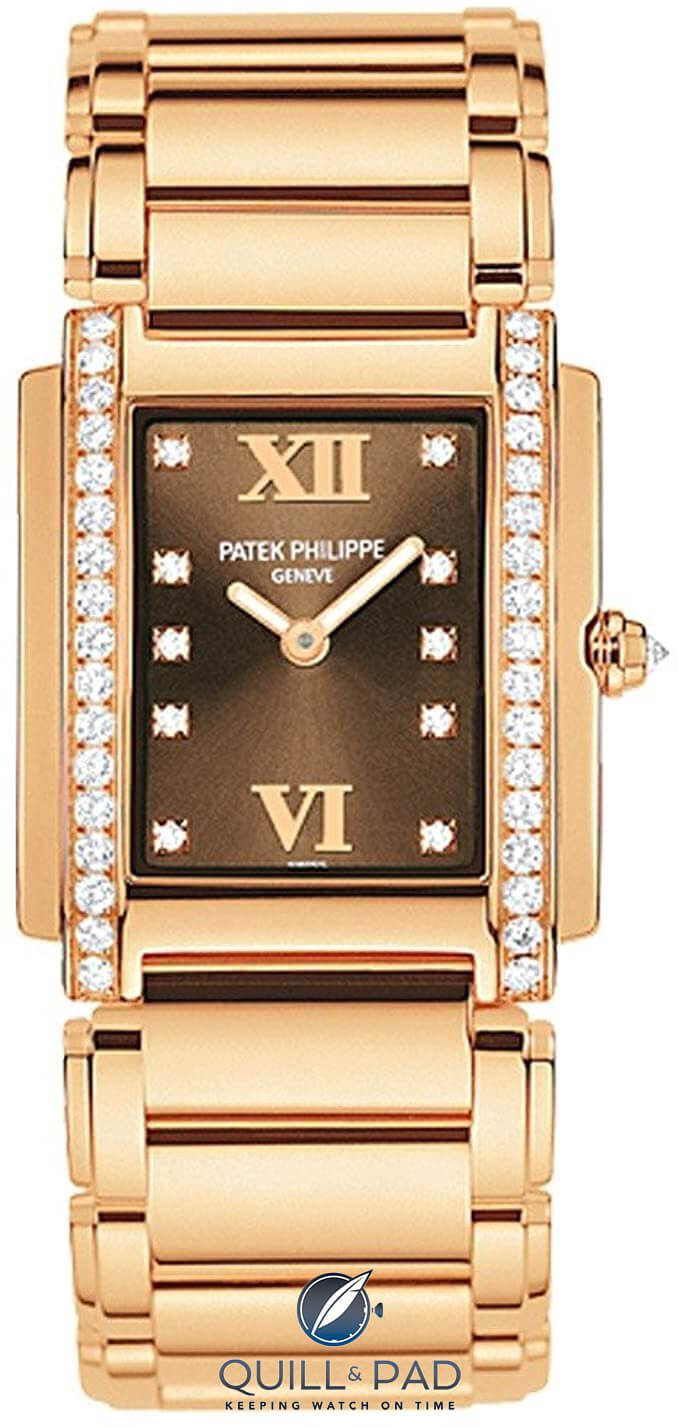
At the turn of the millennium Patek Philippe added gold to the Twenty~4 collection (here: Ref. 4910/11R)
This hardly came as a surprise as there is always a strong demand for gold timepieces among Patek Philippe’s clientele. Even a sporty steel icon like the Nautilus is available in a variety of gold versions.
The gold Twenty~4 models were identical to the stainless steel ones, featuring the same movement and dimensions, except the white gold version, which had a double row of diamonds on the brancards.
This version makes it all the more clear how much the Twenty~4 looks like the Gondolo Reference 4825, although more stylized and contemporary in its lines.
While one could argue that Patek Philippe added the diamonds to differentiate the white gold from the stainless steel version – much the same way the brand adds a single diamond underneath the lower lugs to the case of all its platinum watches – there is another detail that sets them apart: where the first-generation stainless steel models have an onyx cabochon set in the crown, Patek Philippe uses a faceted diamond for the gold Twenty~4 models.
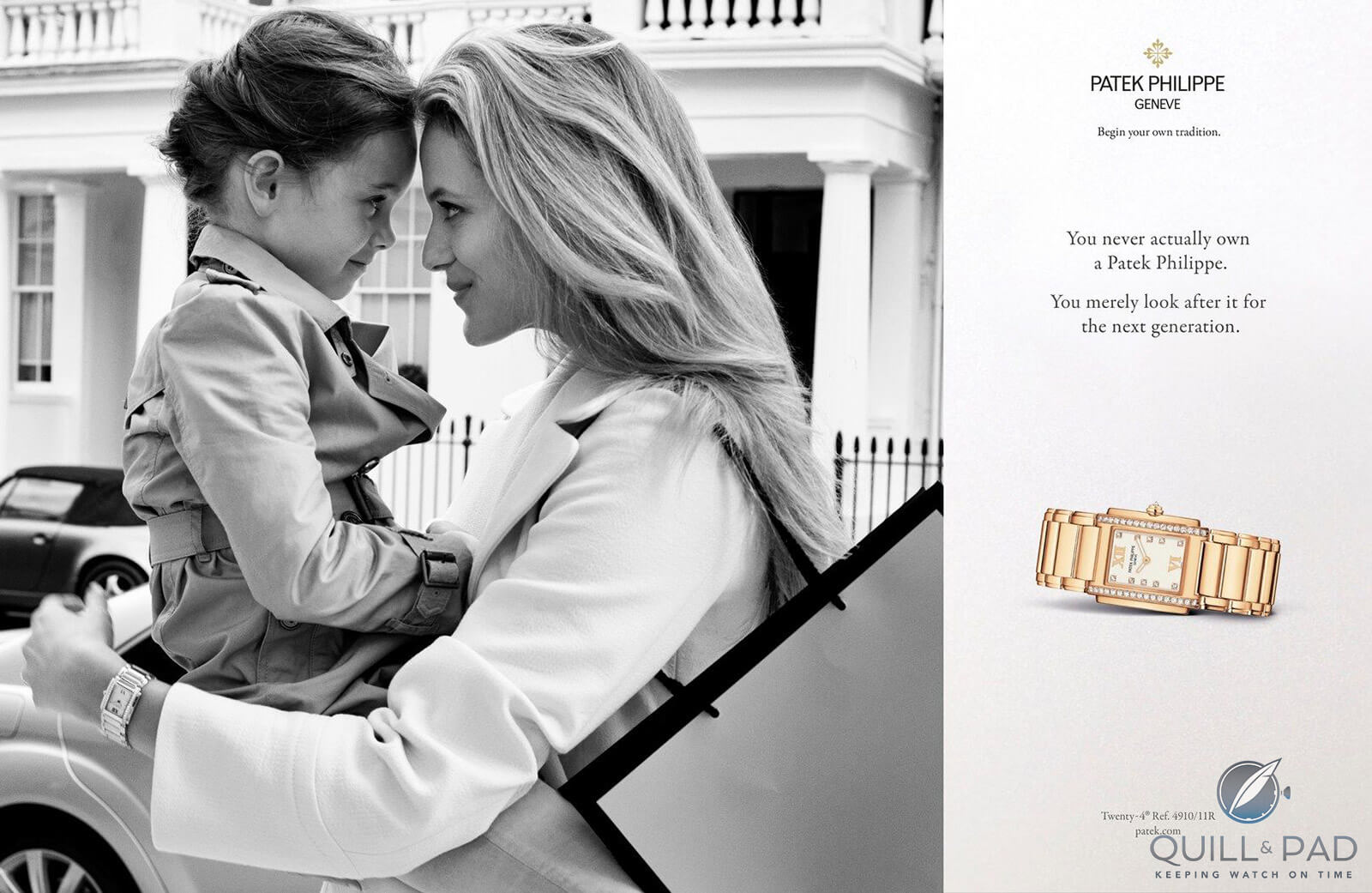
The Twenty~4 was also part of Patek Philippe’s highly successful ‘Generations’ ad campaign
In addition to the white gold model, in 2000 Patek Philippe also introduced the Twenty~4 in three different pink gold versions. Two of them featured dial colors we had already seen in the stainless steel models, Timeless White and Forever Black. New was a chocolate brown dial, which goes particularly well with the pink gold case.
On these models, the Roman numerals, the prong settings holding the diamond hour markers, and the hands were made in pink gold.
While the gold model costs more than double the price of the Twenty~4 in stainless steel, this is not as exorbitant as it might first appear: the bracelet requires a significant amount of gold, which also adds quite a bit of heft to the watch and targets a different consumer segment.
The pink gold models don’t hide their precious nature, making them more of a classic proposition in comparison to the stainless steel watches. Here the “Generations” ad campaign comes to mind as it does not take much imagination to imagine a mother and her daughter both wearing different Twenty~4 models perfectly aligned to each of their lifestyles.
A gem of a movement
For most of its life, the Twenty~4 had been powered by Patek Philippe’s quartz Caliber E15. While it is a quartz movement, it’s one with pedigree.
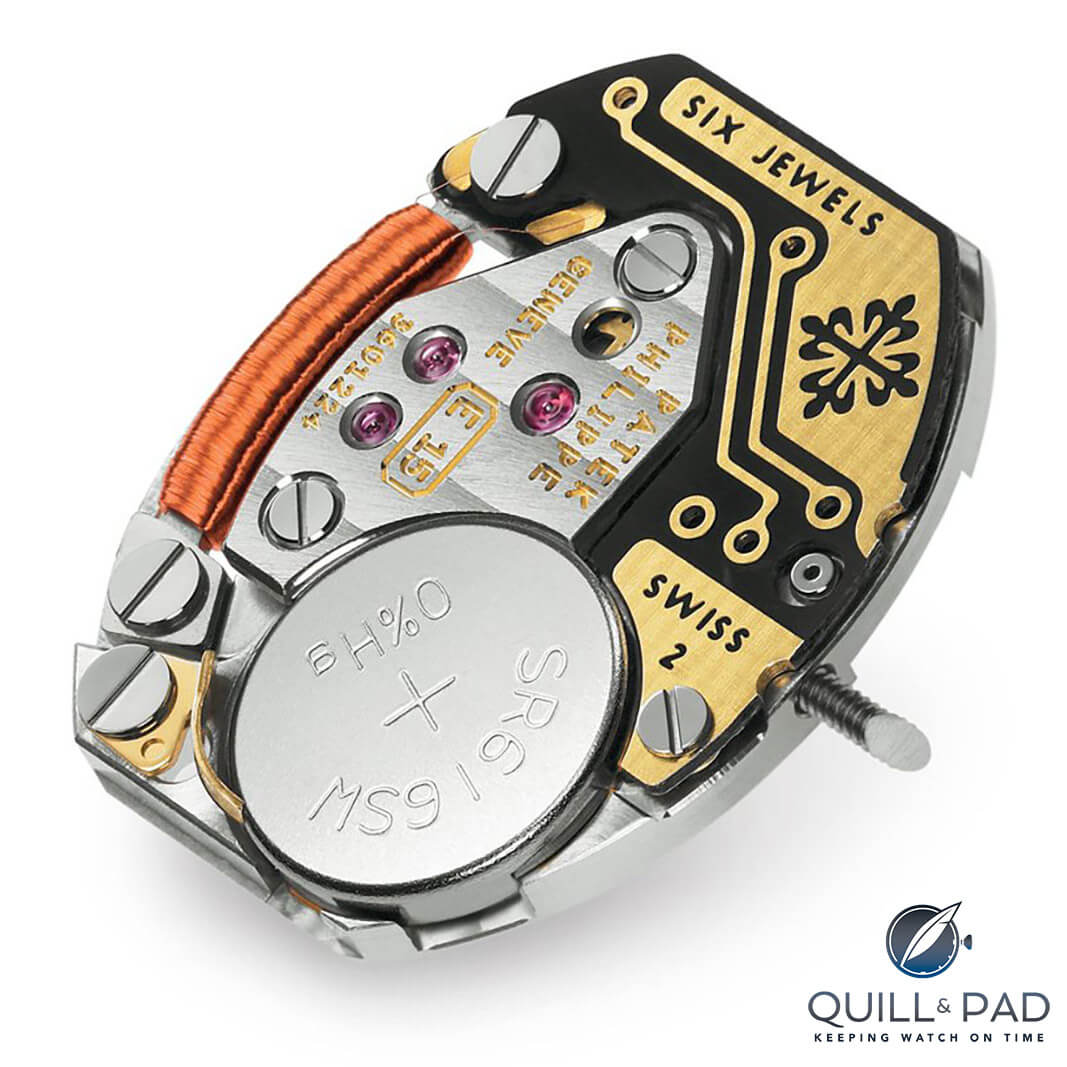
Patek Philippe Caliber E15 is not your average quartz movement
Patek Philippe was a very early adapter where quartz movements were concerned; the brand was also part of the group that developed the original Swiss Beta 21 quartz movement.
Caliber E15 is far more sophisticated than that, comprising 57 parts and measuring 15 x 13 mm while only 1.8 mm high. Six jewels prevent wear on the gears, and a 1.55 V silver oxide battery provides a power reserve of three years.
And just because you can’t see the movement and it is quartz doesn’t mean that Patek Philippe hasn’t paid attention to it’s finishing. The metal bridge at the back of the movement features côtes de Genève, while the front is decorated with an engine-turned motif. While some might (still) object to the thought of a quartz movement inside a noble watch by Patek Philippe, one must keep in mind that the convenience offered by such movements is highly appreciated by some.
To some extent, it is even demanded by the client group Patek Philippe aims for with the Twenty~4.
The diamond years (2002-2004)
Diamonds both highlight the shape of the Twenty~4 and do much for the watch as a whole. Between 2002 and 2004, Patek Philippe released various versions of the Twenty~4 entirely dedicated to diamonds.
The word “dedicated” can be taken quite literally here as the watches featured a full pavé setting, utilizing either brilliant or baguette-cut stones.
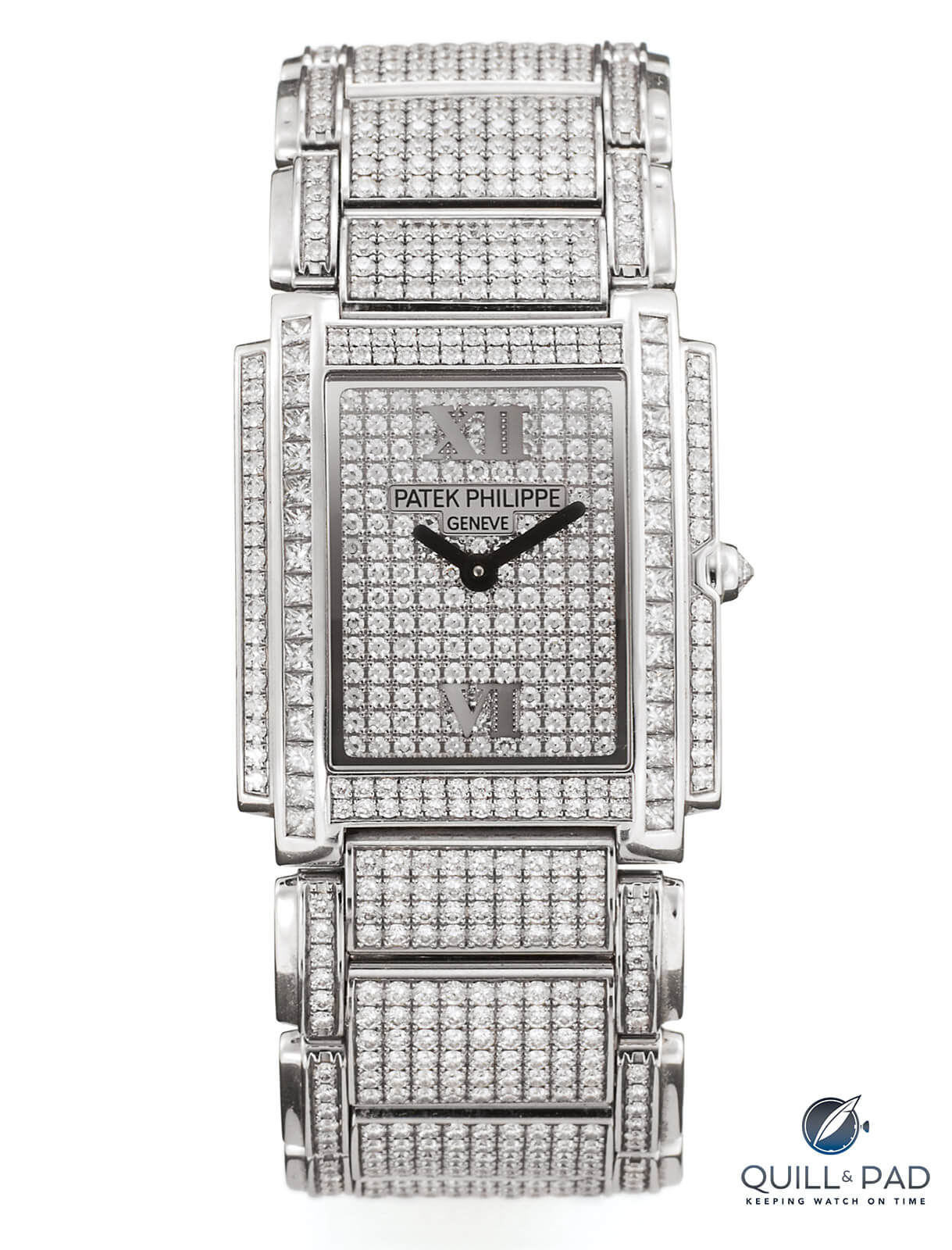
In 2002, Patek Philippe put symmetrically set diamonds center stage in the Twenty~4 collection (photo courtesy Antiquorum)
One of the most interesting aspects of the brilliant-cut diamonds in these watches is that they are set symmetrically, providing a very geometrical experience. As this cut shape has a more or less round girdle, the pavé technique usually sees rows of diamonds set so that they almost fit into each other, allowing for a more compact setting and enabling the full pavé effect to create a “blanket” of diamonds.
While Patek Philippe masters this technique, in this case the brand’s designers and setters chose something different. By going for a symmetrical setting, they beautifully amplified the Art Deco shape of the Twenty~4 while giving it a more contemporary touch in the process.
It might be a subtle detail, but in effect it is a display of brilliant (no pun intended) design.
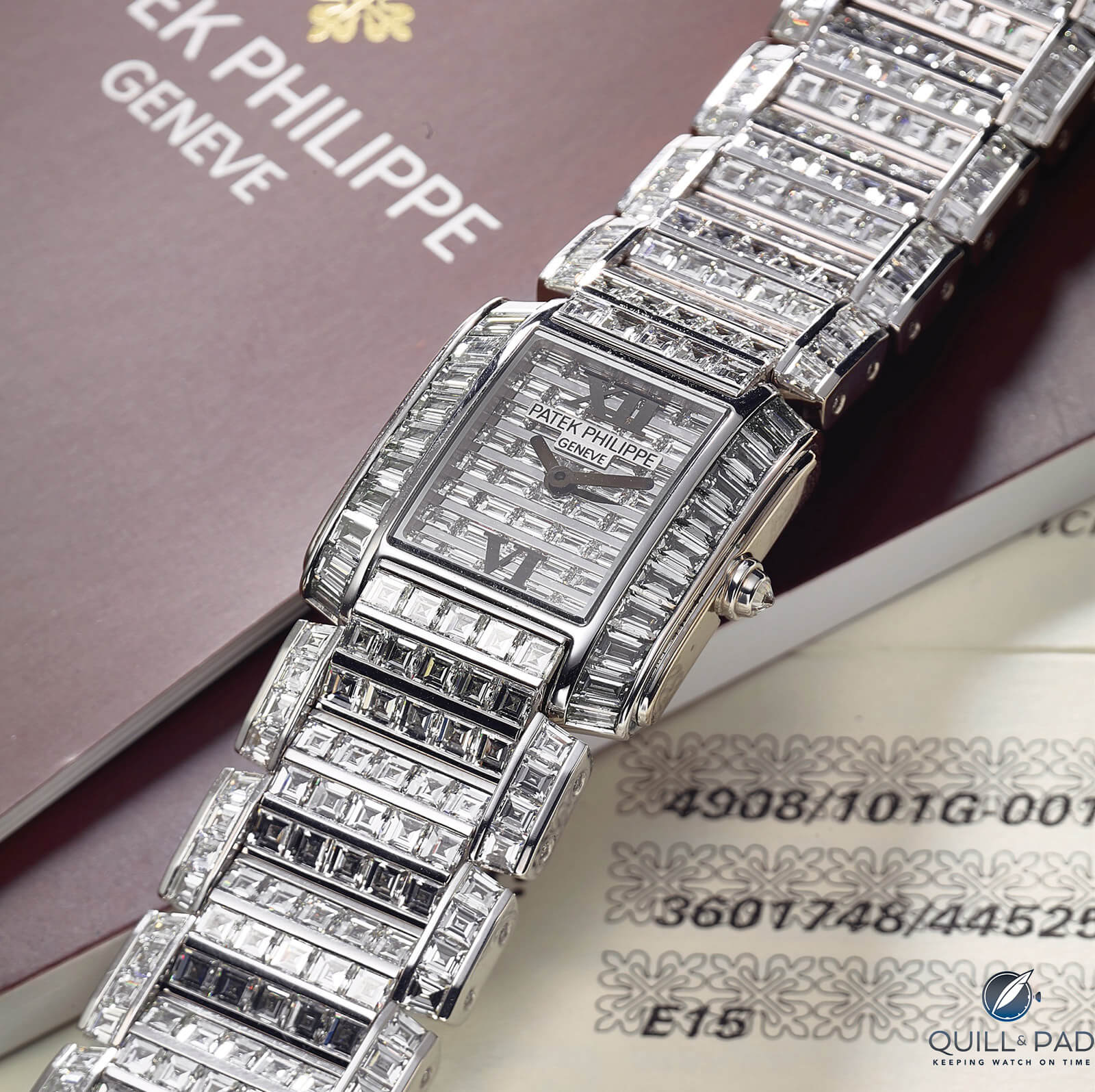
Baguette-cut diamonds, here in Ref. 4908/101G-001, made the Twenty~4 even more precious (photo courtesy Antiquorum)
Along with the brilliant-cut diamond version, Patek Philippe also offered a baguette-cut diamond model. Where I generally prefer brilliant-cut diamonds because they provide a more classical look, here the baguette-cut stones do that very well.
Using the baguette cut seems to soften the shape of the brancards, giving the watch a whole different look. This effect is also more evident in the pink gold version, where the color of the precious metal is more noticeable in between the colorless diamonds.
Needless to say that the carat weight of the Twenty~4 with baguette-cut diamonds is significant. A total of 36.3 carats is needed to cover the entire watch, of which most – 31.72 ct – are used on the bracelet.
The setting is outstanding as is to be expected from Patek Philippe. While these watches are precious because of the materials used, don’t underestimate the craftsmanship and time needed to source, cut, polish, and set all these diamonds.
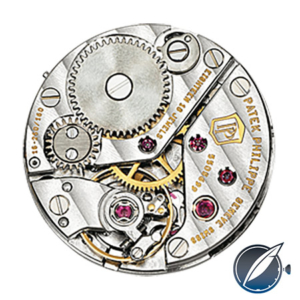
In 2003, the first mechanical movement was welcomed in the Twenty~4 collection: Caliber 16-250
In 2003, things got even more interesting as Patek Philippe released two models featuring brilliant-cut pavé settings combined with a mechanical movement. This was a first for the Twenty~4 collection.
Describing Caliber 16-250 as a bread-and-butter movement is correct, but it is a Patek Philippe bread-and-butter movement, meaning that the bread and butter are handmade using the finest ingredients.
Caliber 16-250 is a mere 2.5 mm high, making it slim enough for a wide range of watches yet not so slim that dependability may become an issue. Initially, the movement was stamped with the Geneva Seal, but as Patek Philippe later replaced this proclamation of quality with its own Patek Philippe Seal movements may feature one or the other.
Patek Philippe used this movement with 38 hours of power reserve for the Pagoda, Calatrava, and Ellipse models in addition to the Twenty~4.
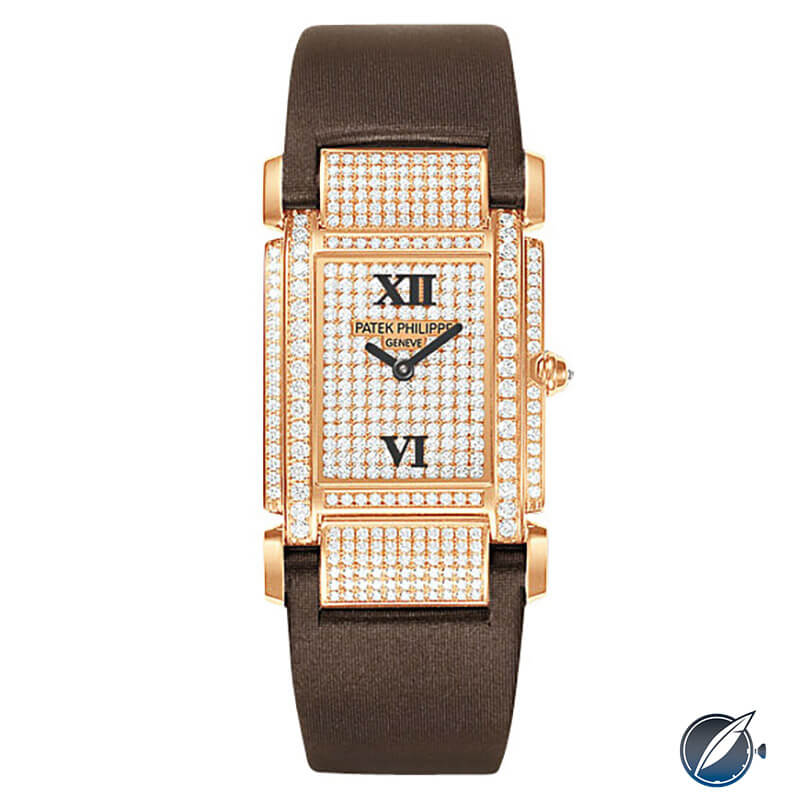
The first Twenty~4 models on straps arrived in 2003, giving the watch a new look (here: Ref. 4910/001R)
The addition of an automatic movement was not the only remarkable introduction in the Twenty~4 collection in 2003: Patek Philippe also released the model on a strap for the first time in that year.
Available in either white or pink gold, Patek Philippe combined a brilliant-cut pavé setting with a soft and silky satin strap, giving the Twenty~4 a distinctly different look.
Additionally, the strap option also allowed Patek Philippe to offer the pavé setting at a lower price point as the watch lacks a bracelet (for which most of the gold and diamonds are needed). The strap also added an extra elegance to the Twenty~4 that we hadn’t seen before.
Even with full diamond setting, the bracelet continued to give the watch a sportive touch, which is why the addition of the satin strap made it look so different.
Quick Facts Patek Philippe Twenty~4 with baguette-cut diamonds (2002)
Case: 24 x 27.75 x 6.8 mm, white (4908/50G-012) or pink (4908/50R-012) gold, case set with 24 baguette-cut diamonds (~2.65 ct), case back set with 72 diamonds (~0.13 ct), bracelet set with 367 baguette diamonds (~30.75 ct) and additional 222 diamonds (~0.97 ct), crown set with one diamond (~0.05 ct)
Dial: set with 39 baguette-cut diamonds (~1.75 ct).
Movement: quartz Caliber E15, 32,758 Hz frequency, 6 jewels
Functions: hours, minutes
Price: approx. €660,000
Quick Facts Patek Philippe Twenty~4 with brilliant-cut diamonds (2003)
Case: 24 x 27.75 x 6.8 mm, white (4909/50G-001) or pink (4909/50R-001) gold, case and case back set with 192 diamonds (~0.91 ct), bracelet and clasp set with 1,128 diamonds (~6.74 ct), crown set with one diamond (~0.05 ct)
Dial: set with 147 diamonds (~0.63 ct.)
Movement: Caliber 16-250, frequency 28,800 Hz, 18 jewels, 38 hours power reserve, Geneva Seal
Functions: hours, minutes
Price: approx. $160,000
Blending models (2004)
In 2004, the Twenty~4 was all about straps: Patek Philippe introduced four different models offering the watch’s original look on satin.
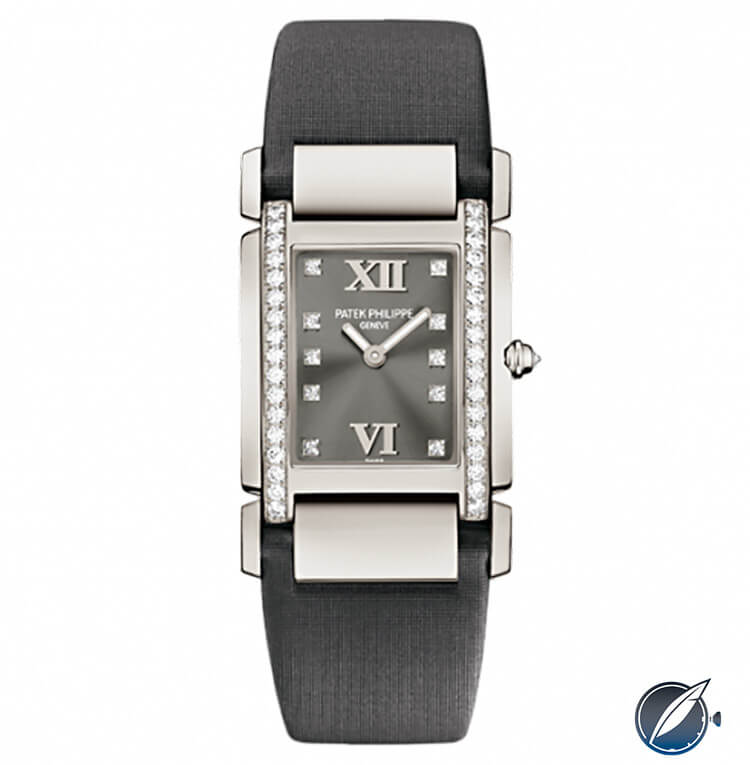
In 2004, Patek Philippe expanded its Twenty~4 offerings on strap (here: Ref. 4920/001G)
The straps dramatically changed the proposition of the Twenty~4, appealing to a slightly different clientele while at the same time maintaining strong collection “DNA.”
These watches were also powered by the E15 quartz movement and used the appealing dial colors of previous models. And even though the initial collection from 1999 was in stainless steel, Patek Philippe did not release a steel model on a strap at this time.
This was certainly deliberate as it would have created an obvious “entry-level” model, and that was not what the satin strap was meant to do. Its intention was to show a different side of the Twenty~4, amplifying its elegance. And to do so properly, its case needed to be gold.
Getting creative (2005-2008)
That the Twenty~4 was also the perfect canvas to get creative with was highlighted in the years to come. In 2005, Patek Philippe gave the watch a daring setting with brilliant-cut diamonds that went seamlessly from the mother-of-pearl dial onto the case and even the bracelet. It underscored the versatility and youthful character of the Twenty~4.
While available with a white gold bracelet, Patek Philippe also offered this watch on a white alligator leather strap, which was another first for the brand.
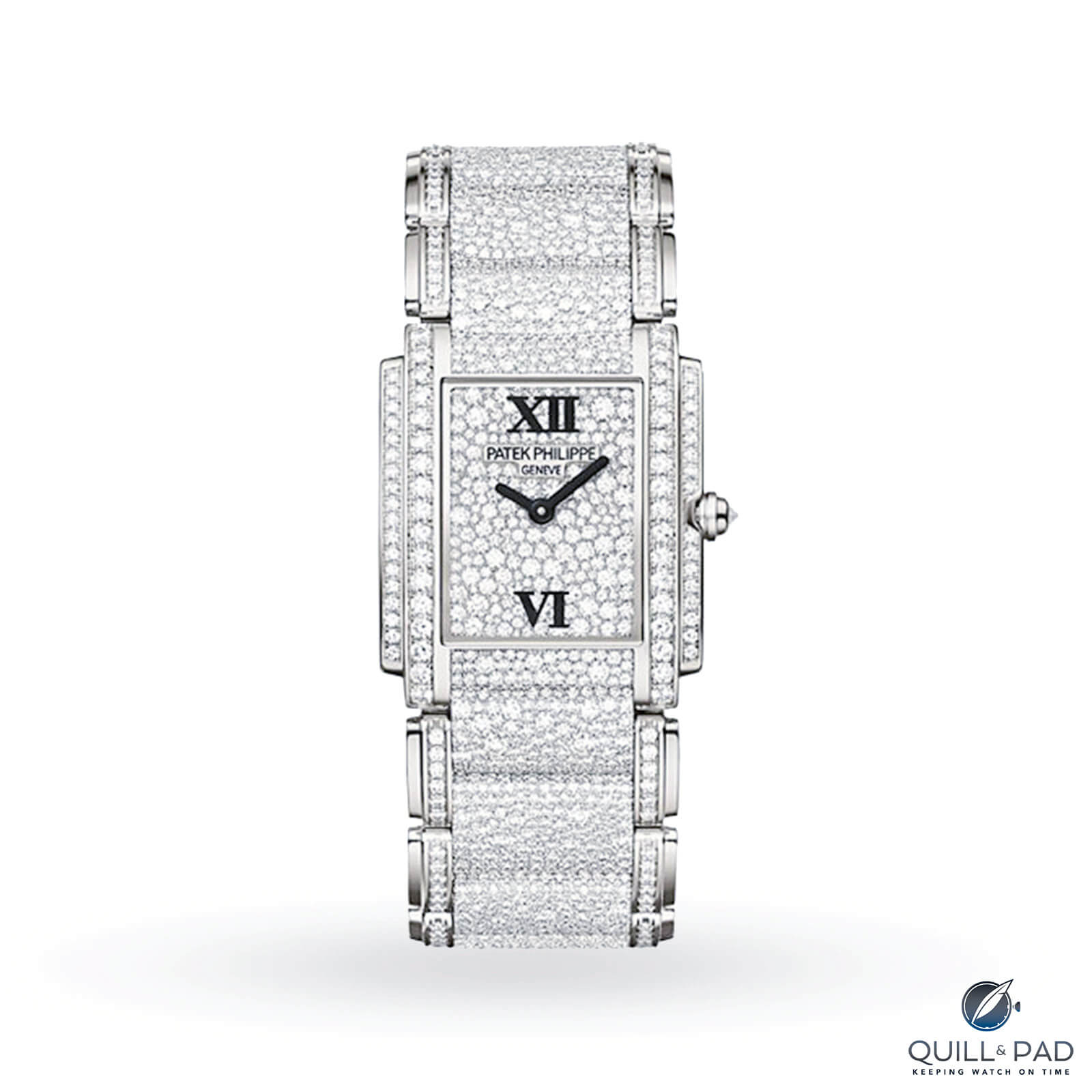
Snow setting gave the Twenty~4 an entirely different look in 2008 (Ref. 4910/52G)
Three years later, in 2008, Patek Philippe offered the Twenty~4 in white gold with a geometric pattern of brilliant-cut diamonds but also in a variation with snow-set diamonds. Snow setting was pioneered by Jaeger-LeCoultre but has since been widely adopted by the rest of the industry.
For me snow setting is one of the most beautiful types of settings available. Setting brilliant-cut diamonds of various sizes randomly yet very closely together provides the effect of freshly fallen snow glistening in the sunlight.
On the Twenty~4, with its manchette-style bracelet, it becomes all the more spectacular. Its design is also very balanced as Patek Philippe set the brancards and bracelet links with brilliant-cut diamonds to keep the lines, but left the outer bracelet segments bare. This provides a cleaner look that automatically draws your attention to the watch head – where the snow setting takes center stage.
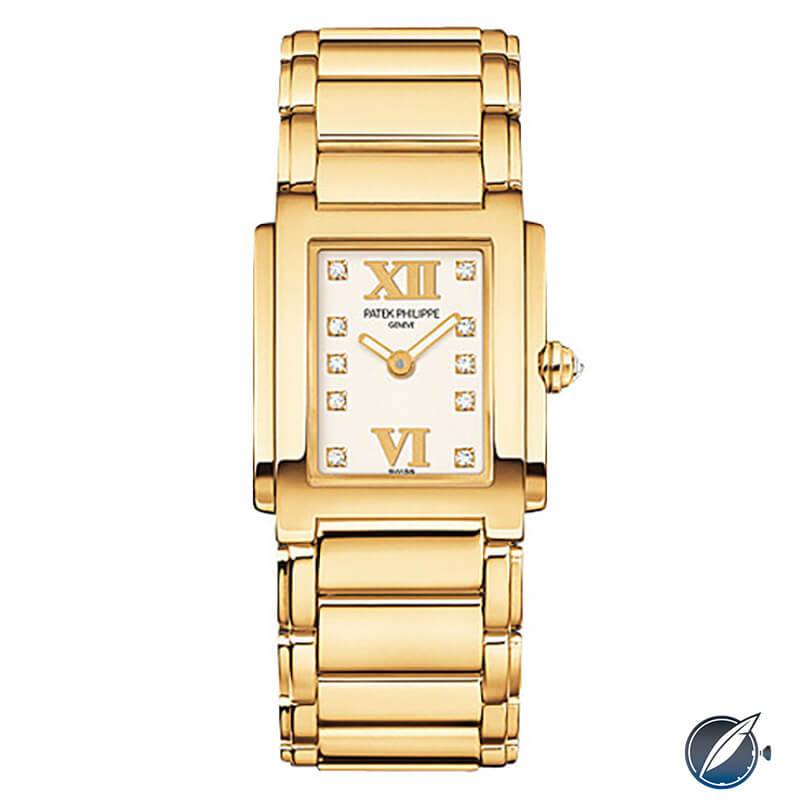
Yellow gold entered the Twenty~4 collection in 2009 (Ref. 4907/1j-001)
Staying power (2009-2010)
Until 2009, the Twenty~4 hadn’t been released in yellow gold, which is perhaps quite surprising from a classic brand like Patek Philippe – a brand that still carries yellow gold models to this day, even though that metal has fallen quite out of style in the modern era.
This might be explained by the trends of the time: yellow gold was rapidly losing the interest of watch consumers at the turn of the millennium in favor of the warmer color of pink gold. A decade later, this changed again as the appeal of gold in its more natural color returned for a short stint.
Patek Philippe cleverly played into this by releasing the Twenty~4 in its purest form. While diamonds still marked ten of the hours on the dial, they disappeared from the brancards, making the watch look like precious and elegant gold bullion on the wrist.
New also was a fumé-effect dial, which worked very well in combination with the yellow gold case and bracelet. As Patek Philippe released these models in a smaller size, 26.3 x 22 mm, this dial also prevented the gold from becoming overpowering.
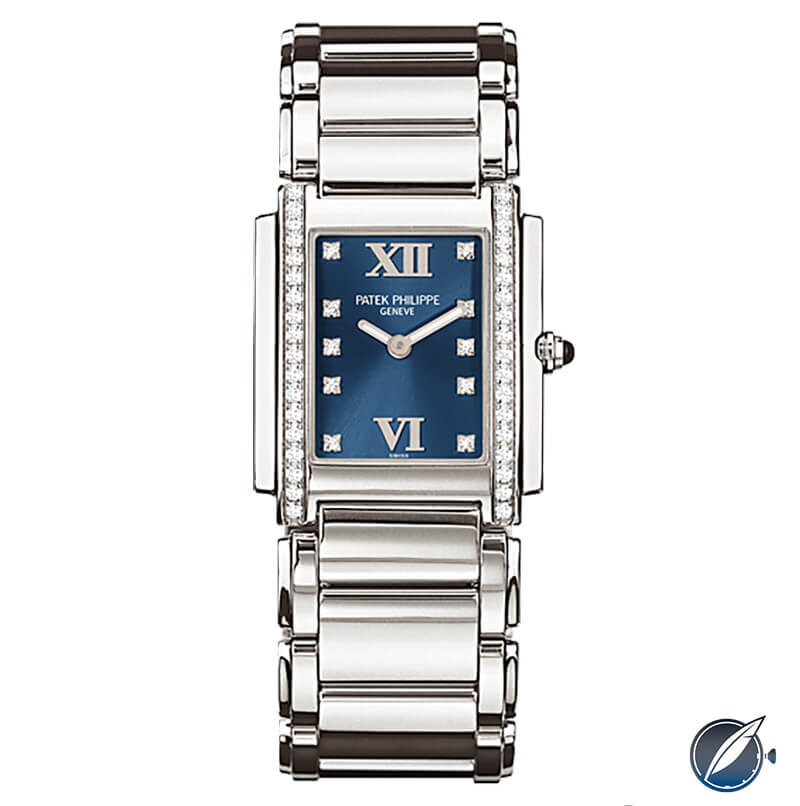
The Patek Philippe Twenty~4 was first available with a blue dial in 2010
Dials were also given center stage the following year when Patek Philippe went back to basics, launching stainless steel and pink gold versions of the Twenty~4 in the same fashion as the 1999/2000 collection, yet now with a blue dial.
Thanks to its satin-like finish, this dial provided a completely new look for a familiar watch. Within the space of a decade, the Twenty~4 proved its staying power to become one of the pillars of the Patek Philippe collection. Its initial charm only intensified with the various models that Patek Philippe brought to the market, but even in its original form the design proved to be as timeless as ever.
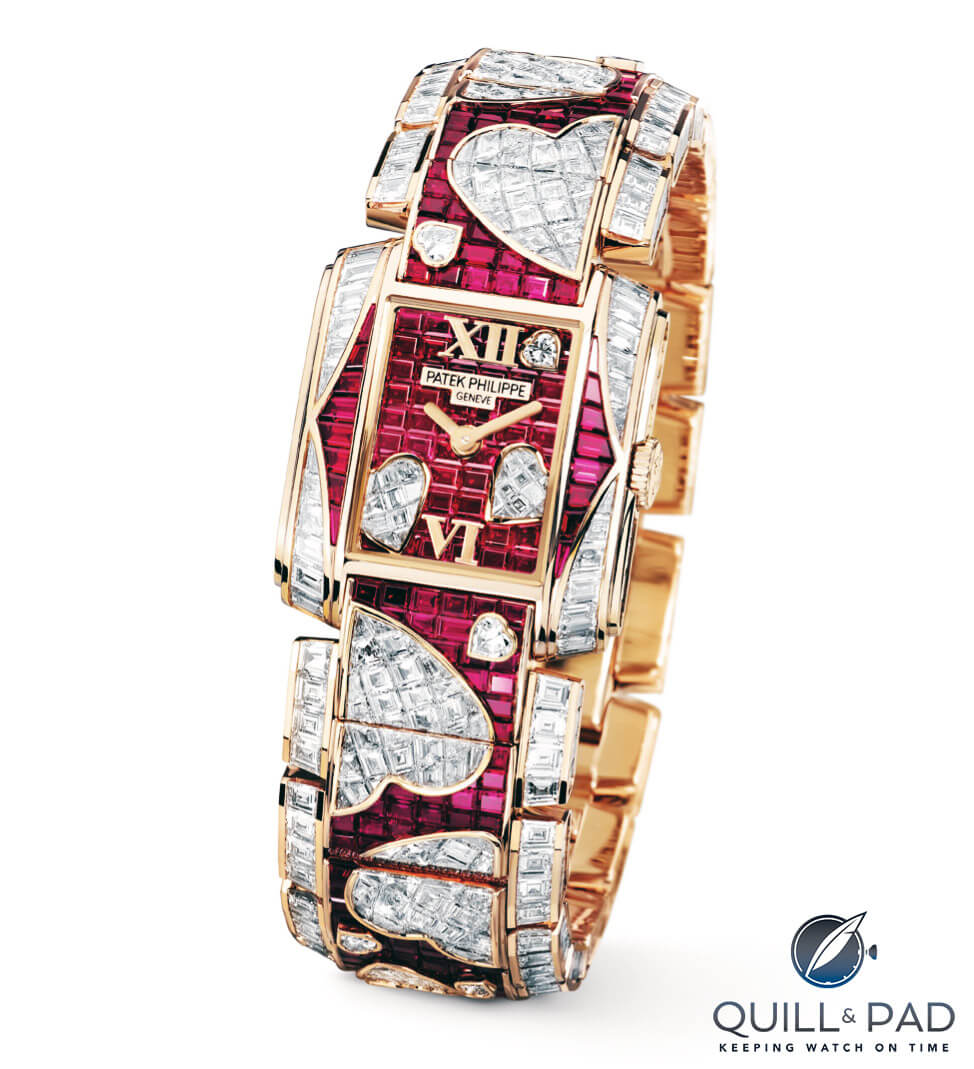
One of the rarest Twenty~4 models ever made: Ref. 4909/103R Hearts is one of five unique pieces
A precious proposition (2012-2015)
The years 2012 and 2015 marked highlights in the history of both the Twenty~4 and Patek Philippe.
In each of these years the brand introduced five unique pieces of the Twenty~4 in which it showcased its considerable skill and experience in gemstone design and setting techniques.
Named Lilac, Flowers, Hearts, Foliage, and Dragonflies, each one of these limited edition pieces offered a different theme that Patek Philippe executed to perfection.
To achieve this, Patek Philippe used vast quantities of precious stones. The Twenty~4 Hearts has the least amount as it is set with “only” 1,920 stones, but as most of these are baguette cut; the total carat weight of all the diamonds and rubies combined is an impressive 66.89 ct.
This also says a lot about the precious nature of these watches. However, the aim of Patek Philippe wasn’t to use as many gemstones as possible but to use them to tell a story.
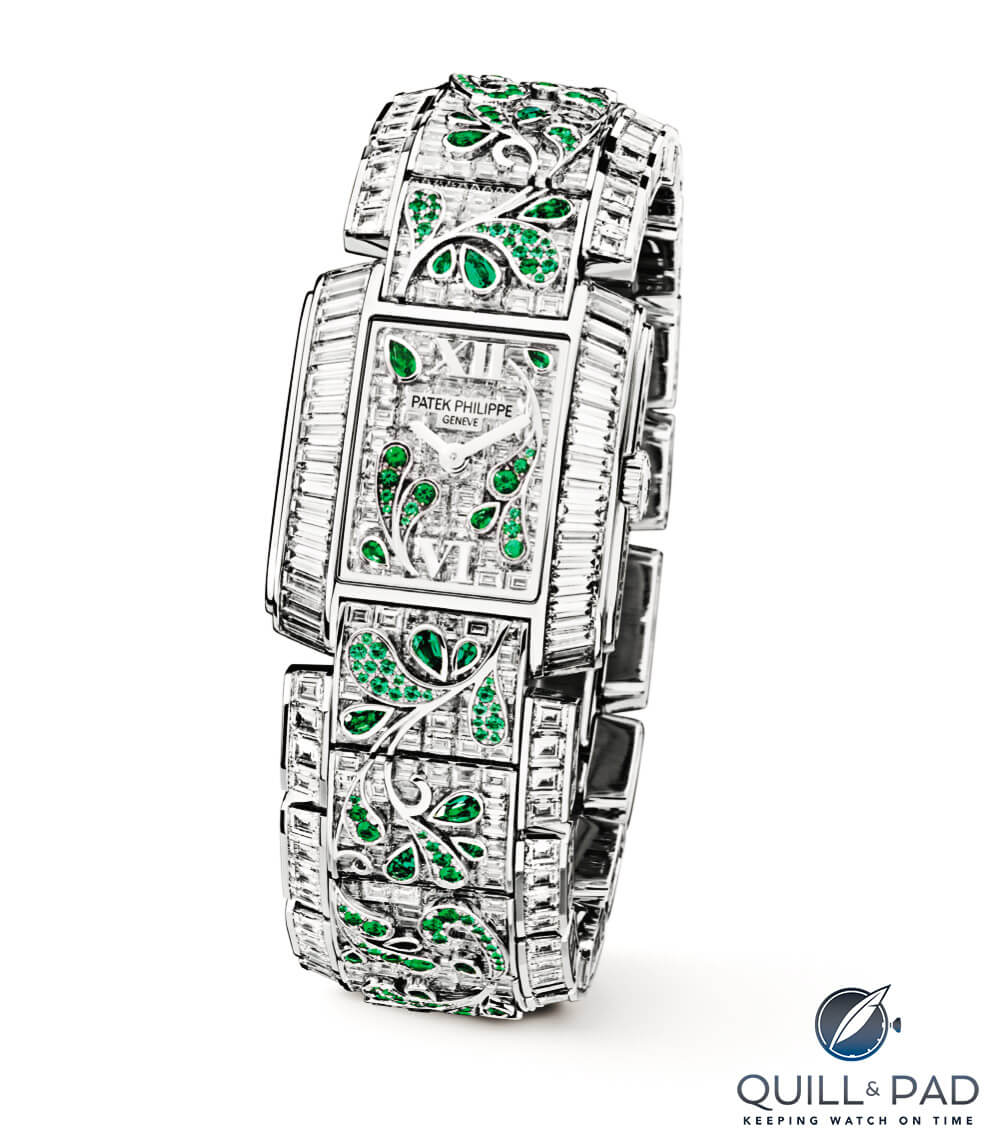
The five unique Twenty~4 models (here Ref. 4909-107G Foliage) showcased Patek Philippe’s abilities in design and gemstone setting
For this, Patek Philippe applied different layers to the bracelets of some of the watches. The Twenty~4 Foliage features, for example, a pavé setting of baguette-cut diamonds on its dial and bracelet, to which is applied a foliage pattern whose leaves are set with emeralds in various cuts and sizes. This allows the themes to really pop, seeming to come to life, blooming right before one’s eyes.
Patek Philippe fitted all five watches with manual-wind Caliber 16-250 so that they remain, even today, the undisputed, ultimate expression of the Twenty~4 collection.
Quick Facts Patek Philippe Twenty~4 Foliage (2012)
Case: 24 mm x 27.75 x 6.8 mm, white gold; case, dial, and case back set with 864 baguette-cut diamonds (~33.64 ct), 855 diamonds (~1.62 ct), 54 marquise-cut emeralds (~1.29 ct), and 241 emeralds (~1.69 ct)
Movement: manually wound Caliber 16-250, 28,800 vph/ 4 Hz frequency, 18 jewels, 38 hours power reserve, Geneva Seal
Functions: hours, minutes
Limitation: one unique piece from a set of five unique pieces
The next chapter (2018-2019): Patek PhilippeTwenty~4 in the round
That set of exquisite unique pieces didn’t mean that Patek Philippe rested on its laurels. In 2018 the brand released an evolution of the Twenty~4: Reference 7300.

Evolution to revolution in 2018: Patek Philippe’s new Twenty~4 Ref. 7300 introduced a new case shape and an automatic movement
To many, this watch might even be considered a revolution as Patek Philippe abandoned the rectangular case shape of the Twenty~4 in favor of a round design.
With a bezel set with diamonds, it might be considered a more conventional watch than the original incarnation of the Twenty~4, yet “the force” was also strong with this one. Its integrated bracelet clearly shows the “DNA” of the collection, as do the dials – even if Patek Philippe exchanged the Roman numerals for Arabic ones, which lend Reference 7300 a bolder look without becoming overpowering.
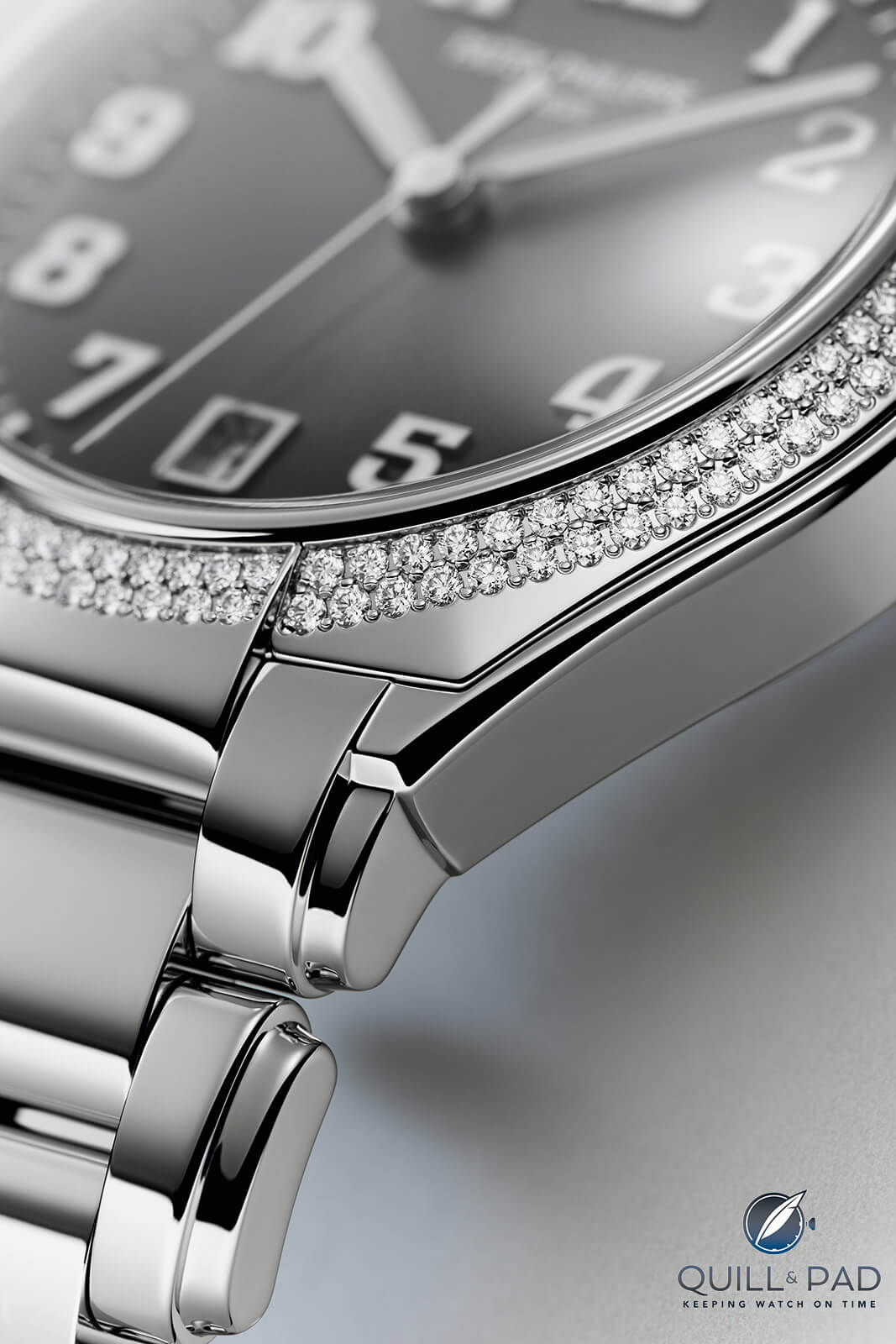
Calling Reference 7300 round is not doing justice to its complex case shape
With a diameter of 36 mm it is still not an overly large watch, but it is perfectly positioned to offer the desired contemporary look without losing its elegance or becoming chunky.
For those same reasons, Patek Philippe paid a lot of attention to the design of the complex case. While it is in essence round, the bezel flares out at the corners, giving it a slight cushion shape and allowing for perfect integration with the bracelet.
The case also has several angular spots, all perfectly polished to provide an astonishing play of light.
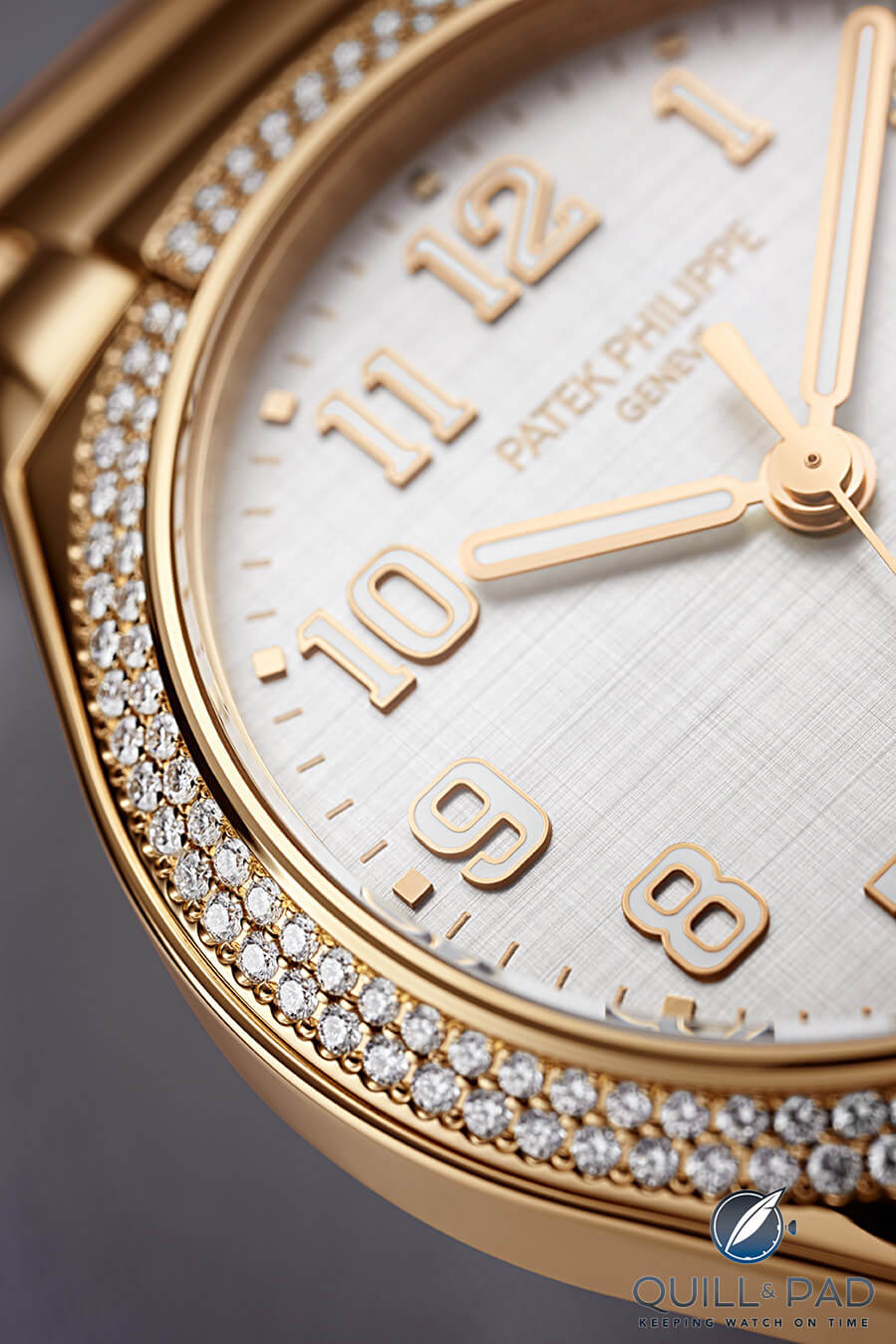
Dial details of Patek Philippe Reference 7300/1200R-010
The vast majority of the Twenty~4 collection has been first and foremost designed to be a watch for daily wear, with versatility a key element.
Reference 7300 takes this to an even higher level, featuring for the first time in this collection a date function and a centrally mounted second hand. Both also play their part in making this Twenty~4 particularly dynamic.
Patek Philippe launched this model in stainless steel, not only perpetuating the sunburst blue dial, but also offering it in a grey tone, which makes the Twenty~4 Reference 7300 rather understated.
Pink gold models were also introduced, either with a brown sunburst dial or a silver one with a unique satin finish in which you can almost recognize the individual brush strokes.
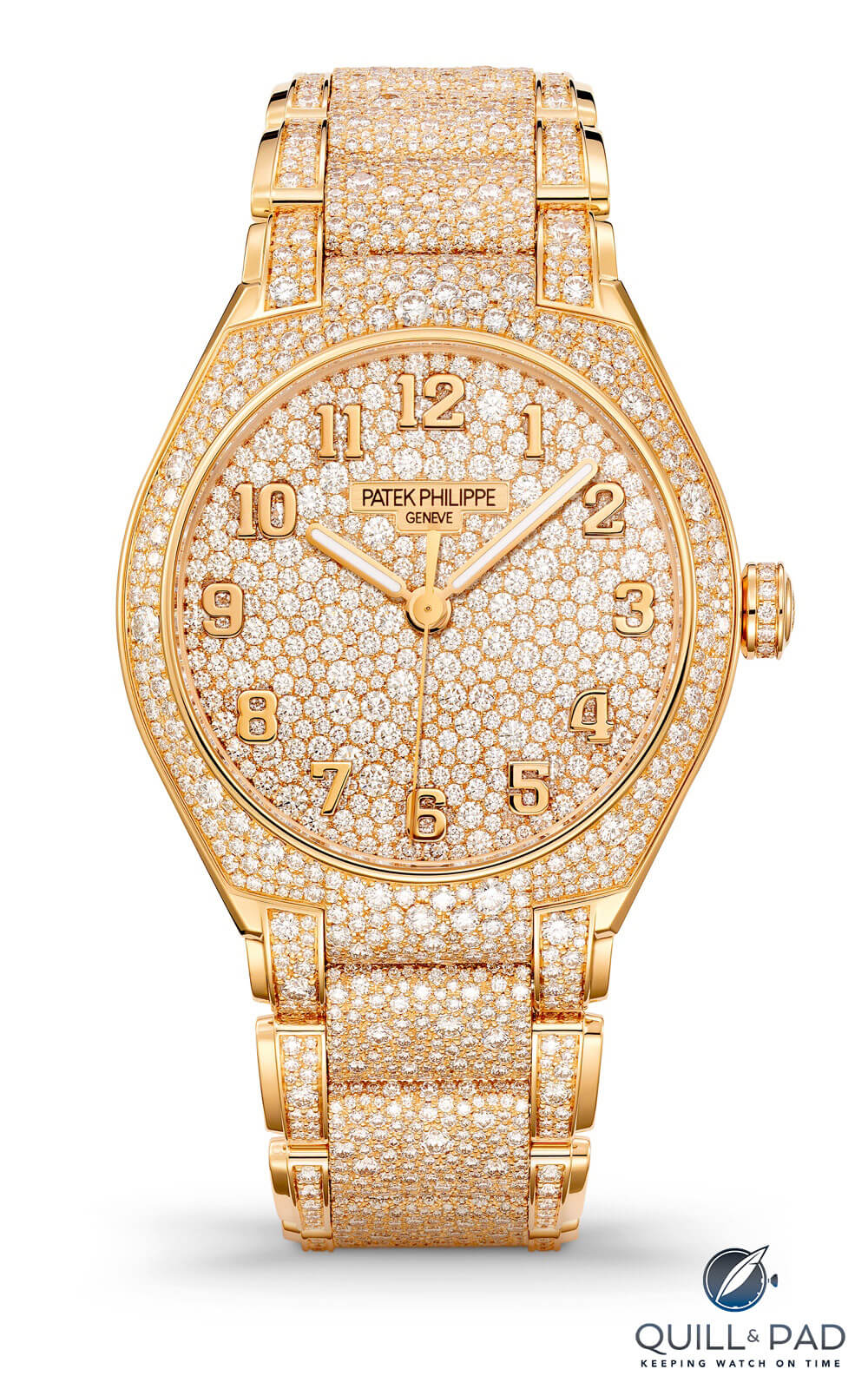
In 2019, Patek Philippe let it snow again on Reference 7300/1450R-001
A year later, in 2019, Patek Philippe returned with a stunning snow-set Reference 7300.
As here the entirety of the case is set, its cushion shape becomes more pronounced. Like on its sibling from 2008, Patek Philippe did not set the outer bracelet links and case elements.
Patek Philippe opted to craft this watch in pink gold. While this may be a bit of a contradiction when using a snow setting, the result is spectacular. Because the color of the gold is more obvious between the diamonds, it augments the difference in the diamond sizes. The perfectly polished Arabic numerals are placed on top of the snow-set diamonds, adding an additional layer of depth to this stunning watch.
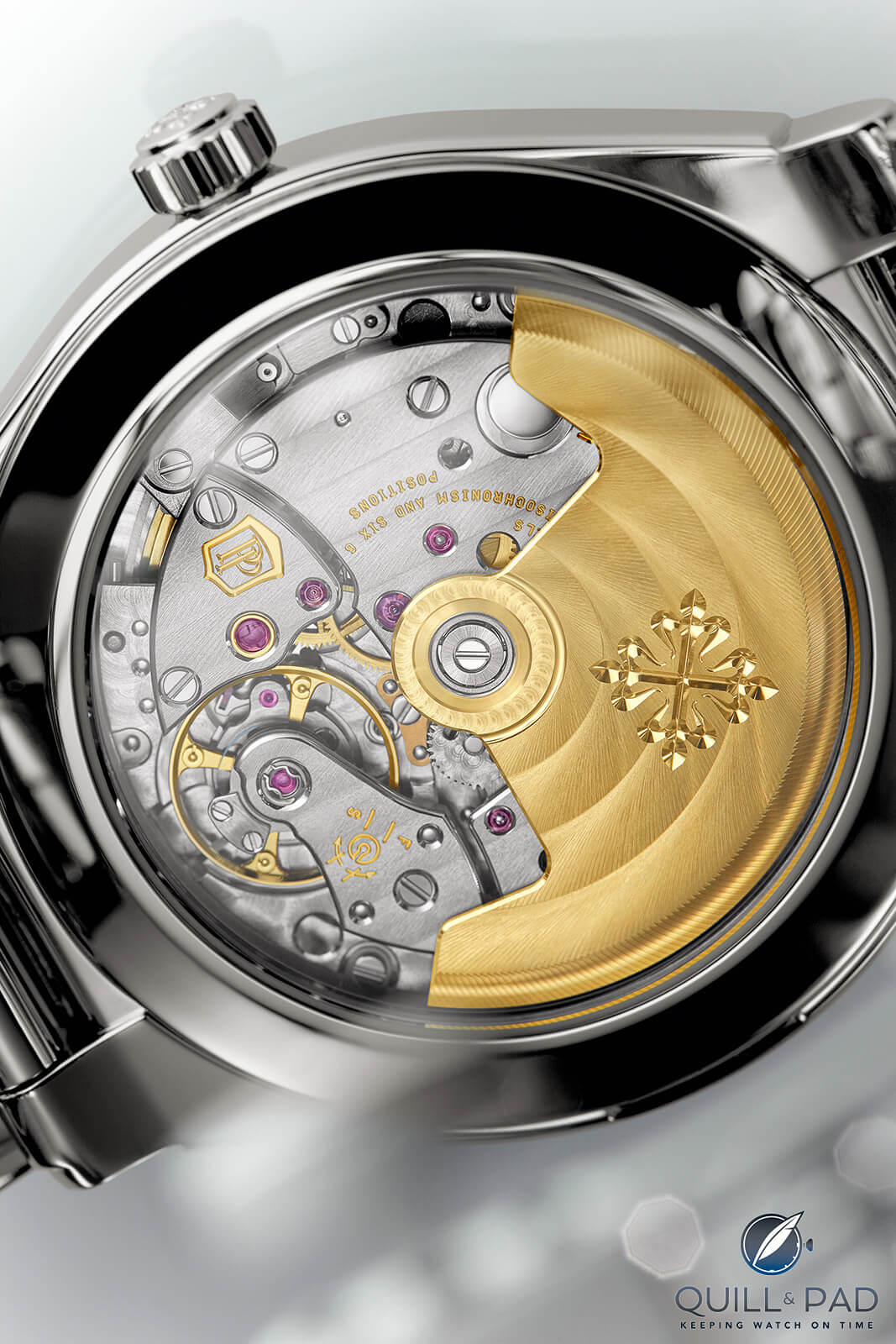
Caliber 324 S C has powered the Patek Philippe Twenty~4 since 2018
Caliber 324 S C, an automatic first for the Twenty~4
Along with Reference 7300, an automatic movement was introduced for the first time into the Twenty~4 collection. Caliber 324 S C is no stranger to Patek Philippe enthusiasts as this movement can be found in the Aquanaut, Nautilus, and Calatrava collections.
Just 3.3 mm high, this movement features a unidirectionally winding 21-karat gold oscillating weight and a Gyromax balance fitted with a Spiromax balance spring for increased precision and a power reserve of 45 hours.
Amplifying the mechanical nature of the Reference 7300 models, the cases are fitted with a sapphire crystal case back so that Caliber 324 S C can be admired in all of its glory.
Quick Facts Patek Philippe Twenty~4 (2020)
Case: 36 x 10.05 mm, stainless steel or 18-karat pink gold, bezel set with 160 brilliant-cut diamonds (~0.77 ct), water resistance 30 m
Dial: blue or gray sunburst dial, two Arabic numerals, and ten hour markers coated with luminous material
Movement: automatic Caliber 324 S C, 28,000 vph/4 Hz frequency, 45-hour power reserve, Gyromax balance, Spiromax balance spring
Functions: hours, minutes
Price: $26,000 (pink gold)
Back to basics (2020)
While Reference 7300 received a very warm welcome, Patek Philippe didn’t abandon the original concept of the Twenty~4 altogether.
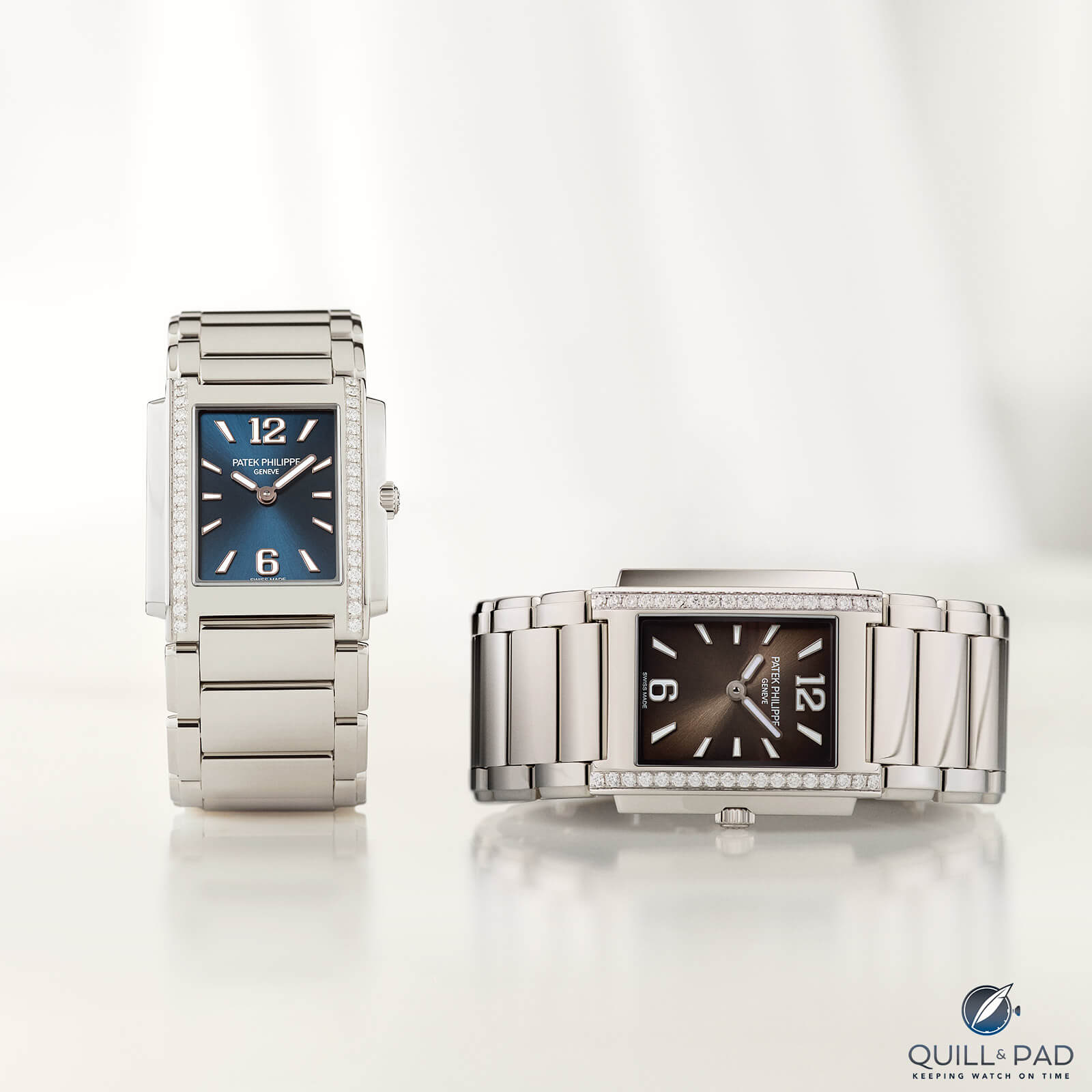
Patek Philippe not forget the quartz origin of the Twenty~4, continued in its original spirit in 2020
Instead, in 2020 the brand gave it a new lease on life with the introduction of Reference 4910/1200A. This quartz-powered model is cut from the same cloth as the first collection of 1999, even boasting the same dimensions.
It has been given yet a slightly more youthful appearance by trading the diamonds on the dial for luminous hour markers. Also, the two Roman numerals on the dial, for more than a decade a hallmark of the Twenty~4, were replaced by an Arabic 12 and 6.
Similar to those on the round Reference 7300, the Arabic numerals give the watch a more contemporary appearance, underscored by the slightly bolder design of the hands, which are also filled with luminous material.
Quick Facts Patek Philippe Twenty~4 (2020)
Case: 30 x 25.10 x 6.8 mm, stainless steel, brancards set with 36 brilliant-cut diamonds (~0.42 ct), water resistance 30 m
Dial: blue or gray sunburst dial, two Arabic numerals and ten hour markers coated with luminous material
Movement: quartz Caliber E15, 32.758 Hz frequency, 6 jewels
Functions: hours, minutes
Price: $14,670
. . . beyond (2021)
Patek Philippe further reinforced the Twenty~4 collection at the beginning of 2021 with three new models.
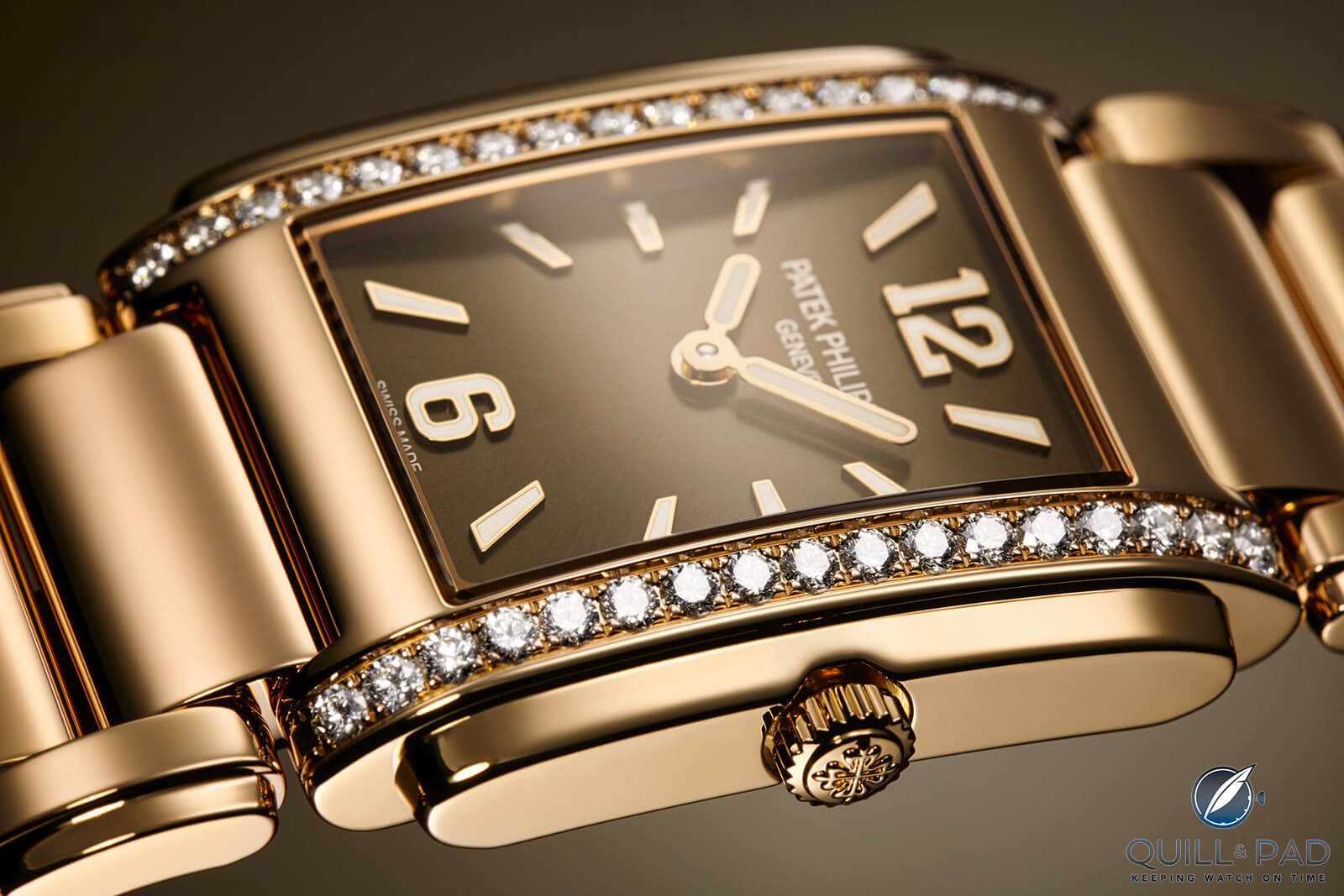
In 2021 the collection expanded with Ref. 4910/1201R-001, bringing gold back to the original manchette style
The restyled rectangular quartz Twenty~4 introduced the year before is now also available with a pink gold case and bracelet. The chocolate brown dial with sunburst motif gives it a very rich look, especially in combination with the brilliant-cut diamonds set on the brancards.
These elements make this Twenty~4 feel almost overindulgent in style and elegance, yet the bold, luminous markers and hands keep the design fresh and modern.
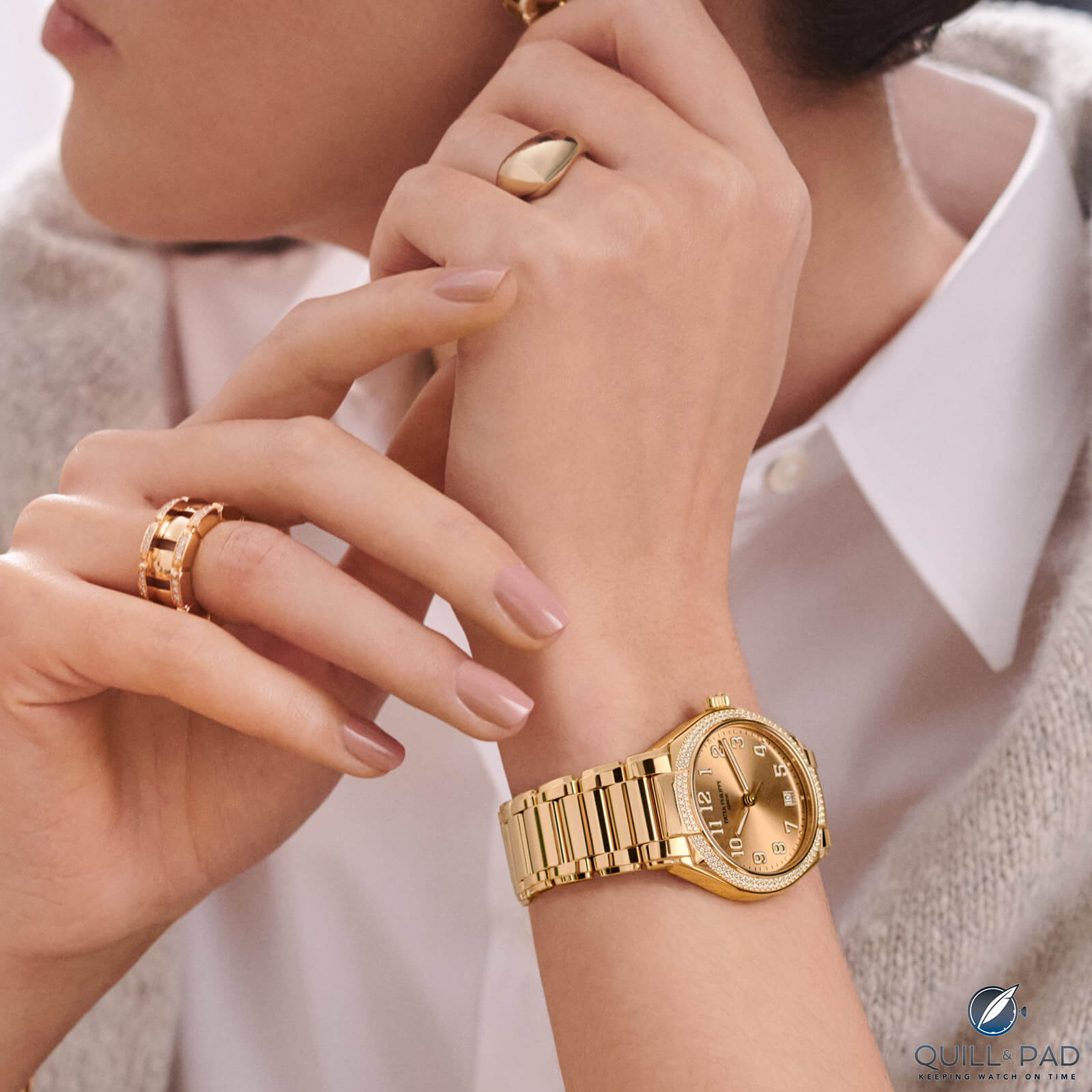
Pink gold entered the Twenty~4 automatic collection with Ref. 7300/1200R-011 featuring a matching dial color
The two other watches join the automatic range of the Twenty~4 and stand out because of their dials. The pink gold variation boasts a dial in the same color, the first time that Patek Philippe has fitted a Twenty~4 with a dial similar in color to its gold case (other than the white dial in white precious metal).
With this, Patek Philippe also resurrects a style that was especially popular in the 1950s and 1960s. In combination with the bold Arabic numerals characteristic of the round Twenty~4, which are an almost vintage military style, this model takes on an appearance we haven’t seen before.
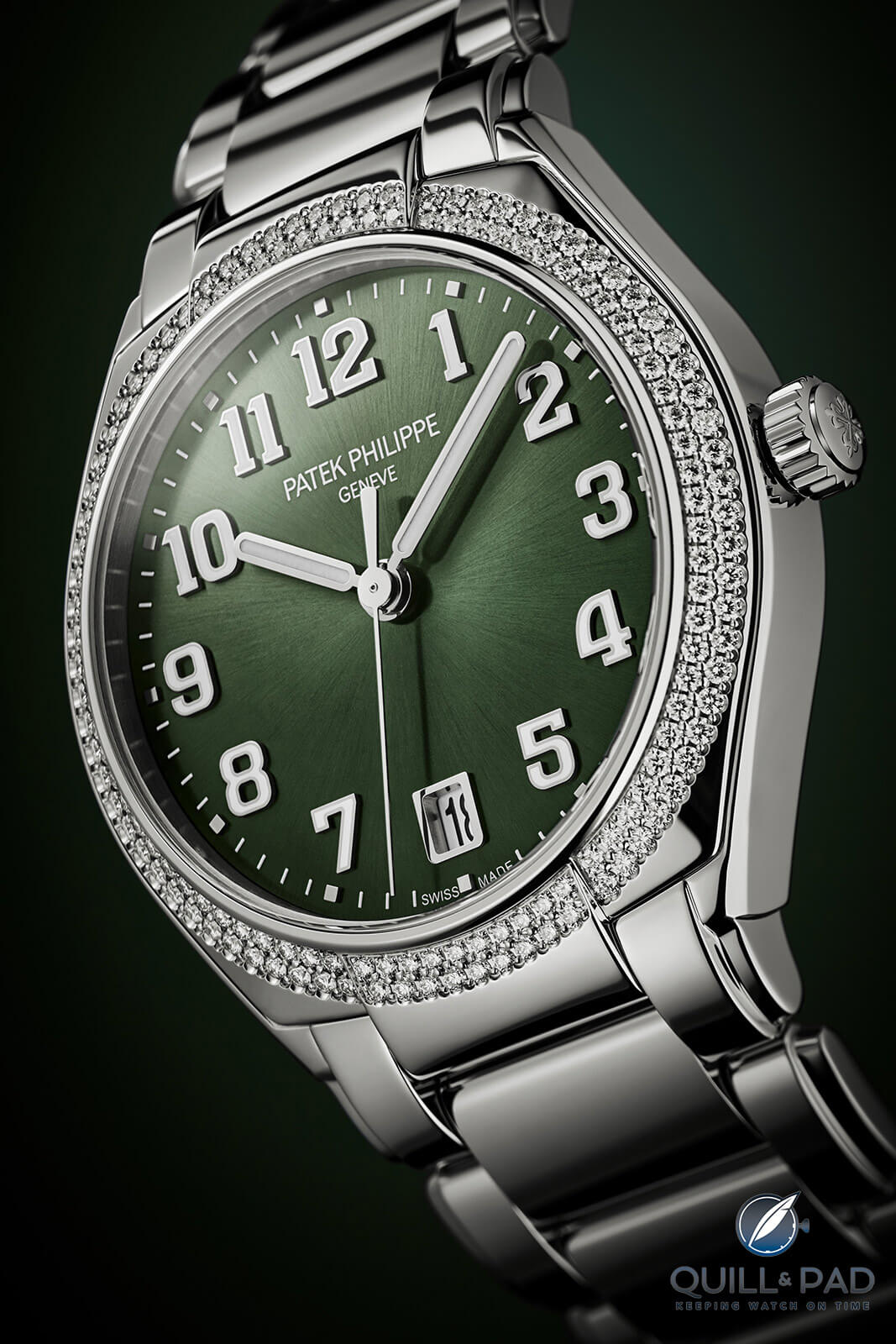
Green is a rare color in the Patek Philippe Twenty~4 line, yet Ref. 7300/1200A-011 proves it can look so good
The same can be said of the third watch that Patek Philippe introduced in the Twenty~4 collection earlier in 2021 where stainless steel is unusually combined with an olive-green dial.
Green has been a rare dial color in Patek Philippe’s collection, generally reserved for the Aquanaut, but it suits the Twenty~4 perfectly. The sunburst finish provides plenty of play of light, and, like its pink gold sibling, makes for a good match with the audacious Arabic numerals. The green also gives a youthful touch to Twenty~4 as it is really the color of this era.
Not that the watch needs a youthful makeover: it has already been going strong for decades.
Looking back at two decades of elegance
Looking with today’s eyes at the first generation of the Twenty~4, it is hard to see it as a product of the past millennium. Its style, elegance, and most of all character haven’t lost any of their charm and still look contemporary.
While Patek Philippe has made changes over the years to keep the Twenty~4 current and slightly broaden its reach among different consumer targets, they are so subtle that even the evolution of the Porsche 911 seems like a series of revolutions compared to them.
The most significant change was the introduction of the round Reference 7300 automatic models in 2018. This model by itself is a testament to how the market has changed in just over two decades, reflecting an increased appreciation for refined mechanical watches among women.
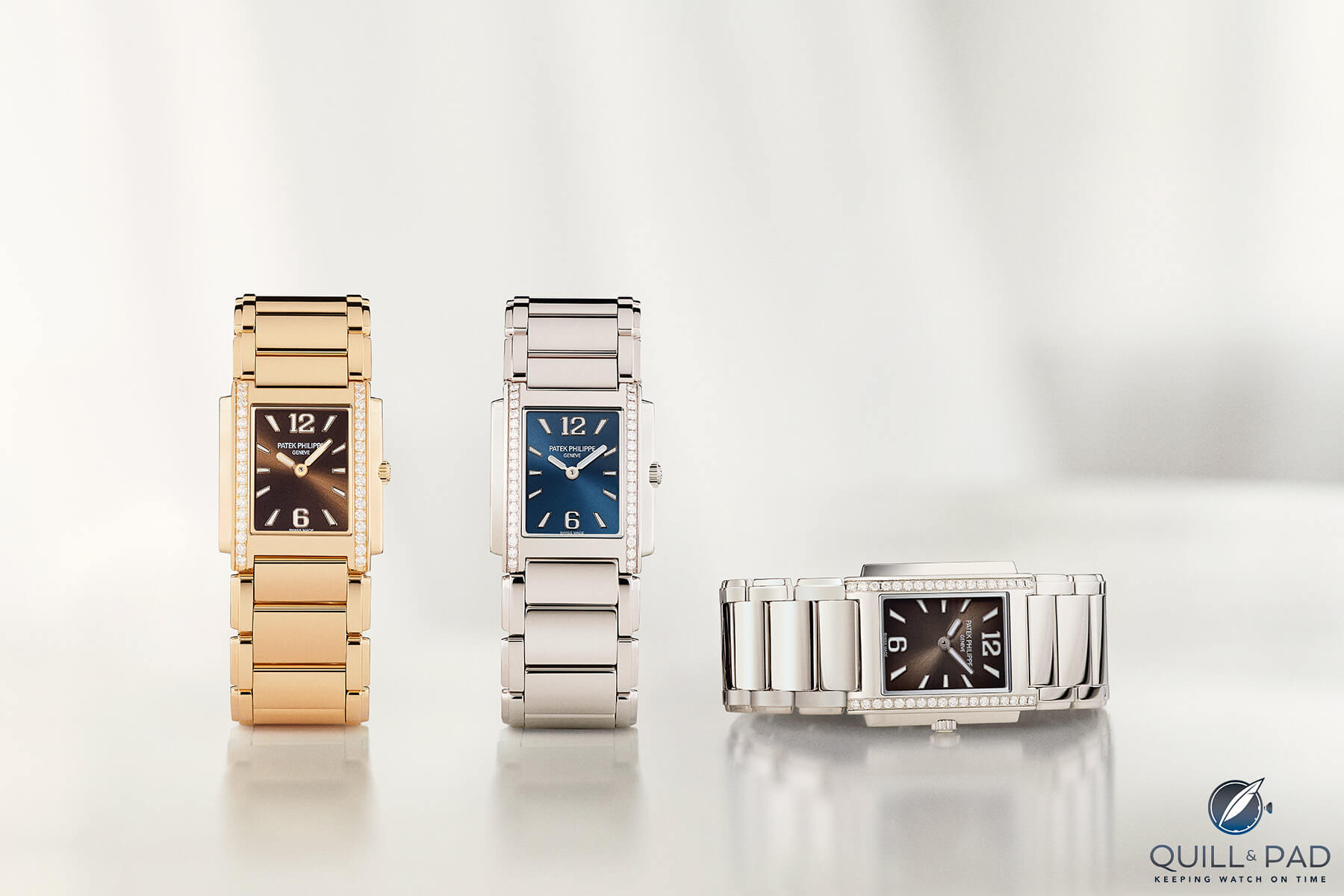
Over two decades later, the original design of the Twenty~4 remains strong and contemporary
They broadened the horizon of the Twenty~4 collection but as the Reference 4910 models introduced in 2020 and 2021 prove, the original design is far from reaching retirement age.
In fact, this original design often plays the important role of welcoming new clients into the world of Patek Philippe, becoming exactly what it was designed for over two decades ago: reliable daily companions transcending fashion and offering a practical, stylish addition to whatever you wear and whatever you do.
For more information, please visit www.patek.com/en/collection/twenty4.
You may also enjoy:
Patek Philippe Twenty-4 Automatic: Women Now Served In The Round
Patek Philippe Calatrava Diamond Ribbon Joaillerie Ref. 4978/400G: Swirl Into Infatuation
The First Wristwatches From Breguet, Hermès And Patek Philippe Were Made . . . For Women.



Leave a Reply
Want to join the discussion?Feel free to contribute!